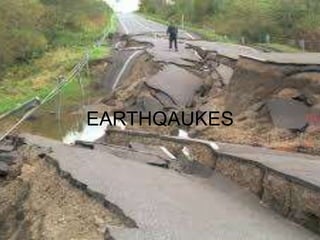
Earthqaukes
- 1. EARTHQAUKES
- 2. EARTHQUAKE • An earthquake is a shaking of the ground caused by the sudden breaking and movement of large sections (tectonic plates) of the earth's rocky outermost crust. The edges of the tectonic plates are marked by faults (or fractures). Most earthquakes occur along the fault lines when the plates slide past each other or collide against each other.
- 3. What causes an earthquake? • There are about 20 plates along the surface of the earth that move continuously and slowly past each other. When the plates squeeze or stretch, huge rocks form at their edges and the rocks shift with great force, causing an earthquake. Think of it this way: Imagine holding a pencil horizontally. If you were to apply a force to both ends of the pencil by pushing down on them, you would see the pencil bend. After enough force was applied, the pencil would break in the middle, releasing the stress you have put on it.
- 4. • The Earth's crust acts in the same way. As the plates move they put forces on themselves and each other. When the force is large enough, the crust is forced to break. When the break occurs, the stress is released as energy which moves through the Earth in the form of waves, which we feel and call an earthquake.
- 5. Fault or fault plane = the surface where when two blocks of the earth suddenly slip past one another Hypocenter = the location below the earth’s surface where the earthquake starts Epicenter = the location on the surface of the earth directly above the hypocenter
- 6. What is a fault? • A fault is an area of stress in the earth where broken rocks slide past each other, causing a crack in the Earth's surface. There are the major types of faults: dip-slip normal, dip-slip reverse, strike-slip, and oblique-slip.
- 7. What are plate tectonics? • The theory of plate tectonics is a interesting story of continents drifting from place to place breaking apart, colliding, and grinding against each other. The plate tectonic theory is supported by a wide range of evidence that considers the earth's crust and upper mantle to be composed of several large, thin, relatively rigid plates that move relative to one another. (See plate tectonic graphic above.) The plates are all moving in different directions and at different speeds. Sometimes the plates crash together, pull apart or sideswipe each other. When this happens, it commonly results in earthquakes.
- 8. What is a seismograph? • A seismograph is an instrument used for recording the intensity and duration of an earthquake.
- 9. What is a tsunami? • A tsunami is a large ocean wave usually caused by an underwater earthquake or a volcanic explosion. Tsunamis are NOT tidal waves. Tidal waves are caused by the forces of the moon, sun, and planets upon the tides, as well as the wind as it moves over the water. With typical waves, water flows in circles, but with a tsunami, water flows straight. This is why tsunamis cause so much damage!
- 10. THE END…